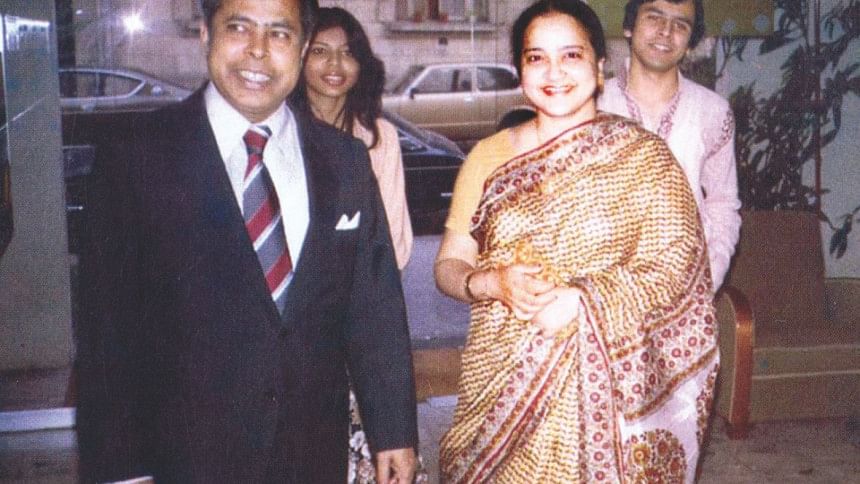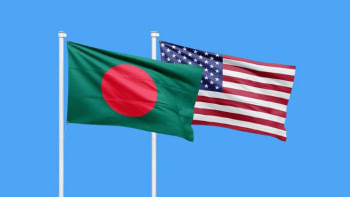Remembering my mother Asma Kibria

In the midst of my sorrow for the recent loss of my mother (on November 9, 2015), I sometimes find myself smiling. Memories dance through my head of a vibrant, creative and deeply determined person. I grieve and I also celebrate the rich tapestry of her life which will always give meaning and depth to my own.
Asma Kibria was born on January 18, 1937. She was the daughter of Ali Ahmed, a renowned member of the Civil Service who was District Commissioner of Faridpur at the time of Asma's birth. Her mother, Monnujan Rani, a graduate of the celebrated Sakhawat Memorial Girls School founded by Begum Rokeya, was a well-known figure in her time, legendary for her generosity, including her charitable works for the poor during the time of the Bengal Famine and the Partition.
From an early age, Asma showed a talent for drawing and painting. It was however not until many years later that she began to actively cultivate her artistic skills. Encouraged by my father, Shah AMS Kibria, she eventually studied painting at the Corcoran School of Art in Washington D.C. and became an abstract impressionist painter. In the course of my father's diplomatic career, she lived in many different cities, from Jakarta to New York. Throughout these travels she eagerly explored the local art scenes she encountered with an eye to learning from them. Over the course of her lifetime, she produced hundreds of paintings and held a series of highly successful exhibitions in Bangladesh and around the world. Her signature style is one of vivid colours and forms in motion that evoke nature and the sights and rhythms of the landscape of rural Bengal. Following the assassination by grenade attack of her husband in 2005, my grief-stricken mother could not bring herself to paint for some time. But she did eventually paint again, finding solace and comfort in the opportunities for creative expression that it provided her.
Besides her painting talents, my mother also had flair for writing. She leaves behind her memoirs that describe the often astonishing course of her life, including her experiences in the many countries to which she travelled. While I am sad that she did not live long enough to complete the volume as she intended, I am also thankful for what she was able to complete which we hope in due course to release for publication.
In the decade following her husband's murder, Asma Kibria continued to play a role that he and she had both played for many years, of family anchor. Multiple generations turned to her for comfort, guidance and support. She was a beloved grandmother, aunt, sister and friend. There were so many people for whom she represented an emotional as well as moral centre. She was the elder who brought everyone together and who could be relied upon to be there for you and also to advise you to adhere to the highest moral principles in every aspect of your life.
Following my father's assassination, my mother took up the cause of justice for her husband's killing. Up until the very end of her life, she fought for a full and transparent investigation that identified not only those who carried out the attack, but also those who planned, financed and ordered it. It is of deep sadness to me that she died not seeing or even knowing that these goals would ever be achieved. More than a decade after the crime, the trial process has now, in 2015, been initiated with the framing of the charge-sheet in the murder case of Shah AMS Kibria. We hope that during the course of the trial the names of all those involved in the killing are identified through the testimony of witnesses and that there will eventually be an opportunity to include the key plotters of the attack in the charge-sheet.
My mother's insistence on the truth, and nothing but the complete truth, was one that cost her in many ways. As she held steadfast to her goals, she also angered and frustrated many in political power through her unwillingness to accept a partial justice for her husband's murder. It is painful for me to remember the deep hurt that she felt as she saw those whom she thought to be allies and friends turn their backs on her. Most difficult to her were the betrayals of those who had worked closely with her husband. In her most despondent moments she would say to me, "Where can we get justice, if even those whom your father trusted the most do not have the will to find and punish his murderers?"
There are other things that my mother should have seen before she died, but unfortunately did not. One of her dreams was to move back to her Dhanmondi property, which she had vacated a few years back in order for a real estate developer to construct a residential building there. When I saw her in her hospital bed a few days before she died, she said to me with tears in her eyes: "I don't think I will be able to fulfill my wish to move to my Dhanmondi flat before I go."
For those of us left behind, it is however not the sadness and regrets that are the most powerful memories. More than anyone else I know, my mother understood and appreciated the preciousness of life. She had an infectious sense of fun, a capacity to enjoy even the smallest of things. Everywhere she went, she made friends. When I find myself welling up in tears at the pain of not having her with me, I also remember her joy of life. This morning I recalled a time when I was about eight years old. I saw my mother, a beautiful woman with sparkling eyes, wearing a yellow and green cotton sari. She was teaching me the Tagore song about the coming of early winter: "Poush toder dak diyeche ayre chhutey ay ay ay." She was teaching me to move to it, raising her arms, bending her fingers and tapping her feet. Mother and daughter together, we happily sang and danced.
The writer is daughter of late Asma Kibria and Professor and Chair of Sociology, Boston University.

 For all latest news, follow The Daily Star's Google News channel.
For all latest news, follow The Daily Star's Google News channel. 



Comments